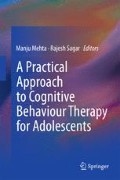Abstract
Pain constitutes a complex multi-dimensional phenomena comprising of sensory, affective, cognitive, and behavioral components. It is broadly classified as acute or chronic pain based on duration. Chronic pain, particularly pertaining to headache and abdominal pain, is highly prevalent in adolescents. It affects various aspects of an adolescent’s life including physical, psychological, and emotional states as well as academic and interpersonal aspects. The cognitive behavioral conceptualization highlights the predisposing, precipitating, and maintaining factors associated with pain. An adolescent with presenting complaints of pain can be assessed through various assessment tools including interview, self-report measures, pain diary/ABC charts, and observation. This chapter elucidates the concept of pain through the cognitive behavioral lens. It highlights the process of assessment followed by planning and conducting cognitive behavioral sessions for the adolescent. Cognitive behavioral management of pain involves three phases, namely, initial, middle, and termination. The initial sessions involve establishing a rapport with the adolescent, explaining the relationship between thoughts, feelings, and pain behavior as well as establishing goals of therapy. Middle sessions focus on teaching the adolescent cognitive behavioral techniques and giving homework assignments. These include relaxation techniques, distraction techniques, structured activity scheduling, and cognitive restructuring. The adolescent is encouraged to take more responsibility while terminating therapy and the progress with possibility of set back post-therapy are discussed. Termination is followed by additional follow-up sessions. The process of therapy may involve certain barriers which may be overcome through timely intervention.
Access this chapter
Tax calculation will be finalised at checkout
Purchases are for personal use only
References
Barretto, E. P., Ferreira, E., & Pordeus, I. A. (2004). Evaluation of toothache severity in children using a visual analogue scale of faces. Paediatric Dentistry, 26, 485–491.
Beck, J. S. (1995). Cognitive therapy: Basics and beyond. New York: Guilford Press.
Brown, R. J. (2007). Medically unexplained symptoms. In N. Tarrier (Ed.), Case formulation in cognitive behavior therapy: The treatment of challenging and complex cases (pp. 263–292). New York: Routledge.
Eccleston, C., Jordan, A., McCracken, L. M., Sleed, M., Connell, H., & Clinch, J. (2005). The bath adolescent pain questionnaire (BAPQ): Development and preliminary psychometric evaluation of an instrument to assess the impact of chronic pain on adolescents. Pain, 118, 263–270.
France, R. D., & Krishnan, R. K. R. R. (1988). Chronic pain. Washington: American Psychiatric Press.
King, S., Chambers, C. T., Huguet, A., MacNevin, R. C., McGrath, P. J., Parker, L., et al. (2011). The epidemiology of chronic pain in children and adolescents revisited: A systematic review. Pain, 152, 2729–2738.
Lipchik, G. L., Holroyd, K. A., & Nash, J. M. (2002). Cognitive-behavioral management of recurrent headache disorders: A minimal-therapist-contact approach. In D. C. Turk & R. J. Gatchel (Eds.), Psychological approaches to pain management: A practitioner’s handbook (2nd ed., pp. 365–389). New York: Guilford Press.
Marks, D. F., Murray, M., Evans, B., Willig, C., Woodall, C., & Sykes, C. M. (2006). Health psychology: Theory, research and practice. New Delhi: Sage.
Melzack, R. (1975). The McGill pain questionnaire: Major properties and scoring methods. Pain, 1, 277–299.
Pradhan, S. C., Anand, K. S., & Biswas, A. (2000). Chronic pain: An interface between neurology and psychiatry. Indian Journal of Medical Sciences, 54, 238–245.
Silva, R. R. (2003). Psychopharmacology news. Journal of Child and Adolescent Psychopharmacology, 13, 409–410.
Silva, R. R., Gabbay, V., Minami, H., Munoz-Silva, D., & Alonso, C. (2005). When to use antidepressant medication in youths. Primary Psychiatry, 12, 42–50.
Author information
Authors and Affiliations
Corresponding author
Editor information
Editors and Affiliations
Rights and permissions
Copyright information
© 2015 Springer India
About this chapter
Cite this chapter
Dhal, A., Mehta, M., Sagar, R. (2015). Pain Management. In: Mehta, M., Sagar, R. (eds) A Practical Approach to Cognitive Behaviour Therapy for Adolescents. Springer, New Delhi. https://doi.org/10.1007/978-81-322-2241-5_9
Download citation
DOI: https://doi.org/10.1007/978-81-322-2241-5_9
Published:
Publisher Name: Springer, New Delhi
Print ISBN: 978-81-322-2240-8
Online ISBN: 978-81-322-2241-5
eBook Packages: Behavioral ScienceBehavioral Science and Psychology (R0)

